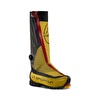E9 6c, the video of John Redhead and Johnny Dawes

 1 / 1
1 / 1 Alastair Lee
Alastair Lee
There are of course only a handful of routes this difficult and in truth there are still few routes graded E9 6c, that magical grade mentioned at the start which for decades was simply unattainable. So difficult that it became "mystical" and "legendary" in the minds of all climbers on the other side of the British channel. The climber who first entered this realm of technical and above all psychological difficulties was young Johnny Dawes who with John Redhead contended an infinite slab on the temple of British climbing, Cloggy. A physical and mental battle which resulted in The Indian Face in 1986, even today one of the most famous trad routes in the UK. Dawes and Redhead… two key figures who in the '80's and '90's marked an era for British trad, as documented in this film Dominic Clemence, now online.



 Copia link
Copia link























